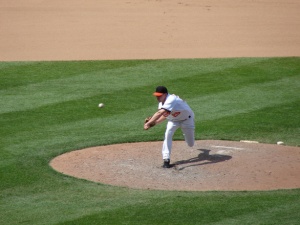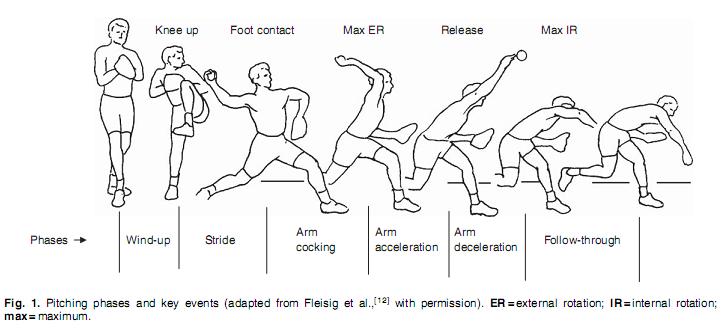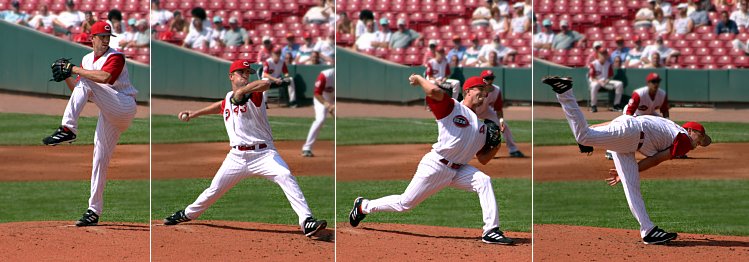Throwing Biomechanics
Original Editor - Vinit Kothekar
Top Contributors - Vinit Kothekar, Vidya Acharya, Kim Jackson, Olajumoke Ogunleye, 127.0.0.1, Rachael Lowe, Naomi O'Reilly, Wanda van Niekerk, WikiSysop and Claire Knott
Introduction[edit | edit source]
Baseball pitching is one of the most intensely studying athletic motionCite error: Invalid <ref> tag; name cannot be a simple integer. Use a descriptive title. Although focus has been more on shoulder, entire body movement is required to perform a baseball pitching. Throwing is also considered one of the fastest human motions performed, and maximum humeral internal rotation velocity reaches about 7000 to 7500o/secondCite error: Invalid <ref> tag; name cannot be a simple integer. Use a descriptive title.
Phases of Pitching[edit | edit source]
Overhead baseball pitching has been divided into four, five or six phases depending on the investigator studying the motionCite error: Invalid <ref> tag; name cannot be a simple integer. Use a descriptive title. But most commonly five phases of overhead baseball pitching has been identified. (1) windup, (2) cocking, (3) acceleration, (4) deceleration and (5) follow through.
Windup[edit | edit source]
- The pitcher is facing the batter with the baseball concealed away from the batter and in the glove, and both the feet in contact of the ground. This is known as the windup stanceCite error: Invalid
<ref>tag; name cannot be a simple integer. Use a descriptive title. - For a right handed pitcher, throwing arm is right arm, gloved hand is left, lead/stride leg is left lower extremity and pivot/stance leg is right.
- The phase of windup begins with the initiation of the stride leg and ends when the ball separates from the glove4 and the stride leg reaches highest pointCite error: Invalid
<ref>tag; name cannot be a simple integer. Use a descriptive title. - The ipsilateral leg and trunk rotation approximately 90o and contralateral hip and knee flexCite error: Invalid
<ref>tag; name cannot be a simple integer. Use a descriptive title. - During windup phase the energy is transferred from stride leg to pivot leg and winding up of the stride leg occurs. It is an important phase which is responsible for imparting the velocity which is driven to the point of ball release. It is reported that about 50% of the velocity of the ball during overhead throw is generated from step and body rotationCite error: Invalid
<ref>tag; name cannot be a simple integer. Use a descriptive title. The body’s overall center of gravity is raised and minimal stress is imparted on shoulder during this phaseCite error: Invalid<ref>tag; name cannot be a simple integer. Use a descriptive title. - The purpose of windup is threefold, (1) to establish a rhythm to achieve correct timing for subsequent movements, (2) to conceal the ball and distract the hitter and (3) to place the body in a position that may contribute to the propulsion of the ballCite error: Invalid
<ref>tag; name cannot be a simple integer. Use a descriptive title.
Cocking[edit | edit source]
Cocking phase is further divided into (a) early cocking and (b) late cocking.
Early cocking phase
[edit | edit source]
- It begins with end of windup phase or when the stride leg reaches its maximum height and it ends when the stride leg contacts the mound/groundCite error: Invalid
<ref>tag; name cannot be a simple integer. Use a descriptive titleCite error: Invalid<ref>tag; name cannot be a simple integer. Use a descriptive title. - During an ideal pitch, at this point the throwing arm is in ‘semi-cocked’ position. With arm approximately in 90o abduction, 30o horizontal abduction, and 50o external rotationCite error: Invalid
<ref>tag; name cannot be a simple integer. Use a descriptive title. - As the ball is removed from the glove, the center of gravity is lowered by flexing the knee of pivot leg and the stride leg gradually extends and move towards the batterCite error: Invalid
<ref>tag; name cannot be a simple integer. Use a descriptive title. - Its main function is to allow a linear and angular motion of the trunk, which lands directly in front of the pivot leg with toes pointing slightly inCite error: Invalid
<ref>tag; name cannot be a simple integer. Use a descriptive title. Knee and hip of the pivot leg extend and initiate pelvic rotation and forward tilting followed by upper torso rotationCite error: Invalid<ref>tag; name cannot be a simple integer. Use a descriptive title.
Late Cocking phase
[edit | edit source]
- This phase begins from the point stride leg contacts the ground to the point of maximum external rotation of throwing arm.
- During this phase, the trunk is perpendicular to the batter and upper extremity position is finalizedCite error: Invalid
<ref>tag; name cannot be a simple integer. Use a descriptive title. The pelvis reaches its maximum rotation and upper torso continues to rotate and tilt forward and laterally. - Shoulder is abducted about 90o, 10o to 20o horizontally adducted and laterally rotates to about 175o. Wrist is in neutral and elbow is elevated about shoulder height and is 90o flexed.
- During this phase, a varus torque of about 64 N-m is generated at the elbow and about 67 N-m internal rotation torque is generated at the shoulderCite error: Invalid
<ref>tag; name cannot be a simple integer. Use a descriptive title. Scapula is elevated and upwardly rotated which provides adequate subacromial space to avoid impingement.
Acceleration[edit | edit source]
- The acceleration phase begins from point of maximum shoulder external rotation to the point of ball release.
- The trunk continues to rotate and tilt, and energy transferred through upper extremity.
- During this phase, the shoulder moves into horizontal adduction and internal rotation. A rapid shoulder internal rotation takes place and shoulder moves from point of 175o of humeral external rotation to 100o of humeral internal rotation in about 42 to 58 millisecondsCite error: Invalid
<ref>tag; name cannot be a simple integer. Use a descriptive title. - Ball release takes place between 40o and 60o of humeral external rotation. The elbow first moves to about 120o of flexion and then rapidly extends to about 25o of flexion at ball releaseCite error: Invalid
<ref>tag; name cannot be a simple integer. Use a descriptive title. At ball release elbow extension velocity peaks at approximately 2500o/sec. The wrist moves into flexion from extended position and ends in neutral, while forearm is in about 90o pronation at release.
Deceleration[edit | edit source]
- It occurs from the point of ball release to maximal humeral internal rotation and elbow extension.
- Shoulder is abducted 100o, humeral rotation reaches 0o and arm is horizontally adducted to 35o.
- Greatest amount of joint loading is generated during this phase. Posterior shear force of about 400 N, inferior shear force of 300 N, 1090 N of compressive forces and about 97 N-m of horizontal abduction torque are generated during this phase after ball release.
Follow-through[edit | edit source]
- Follow-through is the phase where the body continues to move forward until the arm has ceased motion.
- The elbow undergoes a rebound effect and is approximately flexed to 45oCite error: Invalid
<ref>tag; name cannot be a simple integer. Use a descriptive title. - During this phase the rest of the body catches up with the arm and it culminates with the pitcher in fielding position.
Muscle activation
[edit | edit source]
Windup[edit | edit source]
- During this phase, there is minimal muscle activity and muscle fire at low intensityCite error: Invalid
<ref>tag; name cannot be a simple integer. Use a descriptive titleCite error: Invalid<ref>tag; name cannot be a simple integer. Use a descriptive title. - As the stride leg is flexed, the weight is transferred from stride leg to pivot leg and hip abductor, adductor and extensors of pivot leg act as weight absorberCite error: Invalid
<ref>tag; name cannot be a simple integer. Use a descriptive title. - Anterior deltoid and pectoralis major work concentrically at glenohumeral joint. Upper trapezius, serratus anterior and lower traps work to produce upward rotation of the scapula. And abdominal muscles work to rotate and stabilize the trunk.
Cocking[edit | edit source]
Early cocking
[edit | edit source]
- Hip extensors and abductors, knee flexors and ankle plantarflexors of the pivot leg work to propel the weight forward as the stride leg is moving forward. And hip extensors and abductors, knee extensors and ankle plantarflexors of stride leg work eccentrically to control the lowering of body’s center of gravity. Abdominal obliques work eccentrically to control excess lumbar hyperextension.
- In the early cocking phase the supraspinatus and deltoid work together to abduct the arm with a peak activity Cite error: Invalid
<ref>tag; name cannot be a simple integer. Use a descriptive titleCite error: Invalid<ref>tag; name cannot be a simple integer. Use a descriptive title. And later during the late cocking phase the activity of deltoid decreases. - The other muscles which produce peak activity during early cocking phase are right extensor carpi radialis longus and brevis, extensor digitorum communis, right gluteus maximus and left oblique for right handed pitcherCite error: Invalid
<ref>tag; name cannot be a simple integer. Use a descriptive title. And the muscle which produce a strong contraction are left erector spinae and left gluteus maximus for right handed pitcher. Whereas trapezius, serratus anterior and pectoralis are moderately active to position the scapula.
Late cocking
[edit | edit source]
- During late cocking phase, the pivot leg hip extensor, knee flexor and calf muscles work concentrically to transfer the force up the kinetic chain and aide in force generation at the arm.
- Serratus anterior and pectoralis major produce their greatest activity during late cocking phase just before maximum external rotationCite error: Invalid
<ref>tag; name cannot be a simple integer. Use a descriptive title. - Infraspinatus and teres minor have their peak activity to externally rotate the arm concentrically and later on their activity is decreased to moderate levels during acceleration phase.
- Subscapularis produces significant eccentric contraction as the humerus passes neutral rotation to control the lateral rotation of the arm.
- Biceps brachii presents with peak activity during flexion of elbow in late cocking phase as it limits anterior translation and compression forces of humeral head. As the wrist extension reaches maximum, the wrist extensor are at its greatest activityCite error: Invalid
<ref>tag; name cannot be a simple integer. Use a descriptive title.
Acceleration[edit | edit source]
- Acceleration phase is the most explosive phase of the pitching, and trunk achieves its greatest rotation speed which leads to peak activity of obliquesCite error: Invalid
<ref>tag; name cannot be a simple integer. Use a descriptive title. - Strong activity of serratus anterior and pectoralis major continues into acceleration as the shoulder moves into horizontal forward flexion and scapula protractsCite error: Invalid
<ref>tag; name cannot be a simple integer. Use a descriptive title. - Latissimus dorsi becomes active during late cocking phase as the arm reaches maximum external rotation and continues to contribute towards humeral internal rotation during acceleration phaseCite error: Invalid
<ref>tag; name cannot be a simple integer. Use a descriptive titleCite error: Invalid<ref>tag; name cannot be a simple integer. Use a descriptive title. - Subscapularis at its greatest activity as it vigorously moves the arm into internal rotation during this phase. Study done by Gowan et alCite error: Invalid
<ref>tag; name cannot be a simple integer. Use a descriptive title found that during acceleration phase, the contraction of subscapularis, serratus anterior and latissimus dorsi was considerably high in professional athletes compared to amateur athletes. - Triceps is also at its greatest activity during this phase as the elbow violently moves into extension and across the body.
Deceleration[edit | edit source]
- This is the most active phase for the muscles of shoulder girdle as they work eccentrically to decelerate the arm.
- Trapezius, serratus anterior and rhomboids produce high MVICCite error: Invalid
<ref>tag; name cannot be a simple integer. Use a descriptive title to assist in deceleration of shoulder girdle. - Teres minor presents with its peak activity during this phase as it resists anterior humeral head translation, horizontal adduction and internal rotation.
- In addition to teres minor, infraspinatus, supraspinatus and deltoid also presents high MVIC to decelerate the arm in space as it moves forward.
- Biceps brachii and brachialis produces marked eccentric contraction to decelerate the elbow extension and forearm pronationCite error: Invalid
<ref>tag; name cannot be a simple integer. Use a descriptive title.
Follow-through[edit | edit source]
During follow-up phase, the trunk extensors work concentrically to bring the trunk in upright position. And as the rest of the body catches up with the arm, the pivot leg hip flexors move the leg forward and the pitcher assumes a fielding position.
Types of Pitches[edit | edit source]
- Different types of overhead baseball pitches are fastball, change-up, curve ball and slider.
- Escamilla et alCite error: Invalid
<ref>tag; name cannot be a simple integer. Use a descriptive title studied throwing mechanics of different types of pitches for overhead throwers, and concluded that fastball was thrown with more pelvis and upper torso angular velocities and stride length compared to curveball and changeup. - Slider is meant to mimic a fastball except with a decreased velocity and addition of horizontal plane movement to fool the hitterCite error: Invalid
<ref>tag; name cannot be a simple integer. Use a descriptive title. Supination of the forearm during late acceleration phase results into rotation of the ball which generates a horizontal plane movement. - The changeup is thrown with same arm slot and motion as fastball, and also the spin is generated in the same direction of fastball. The ball is positioned deeper in the palm to generate a slower velocity which distorts the batterCite error: Invalid
<ref>tag; name cannot be a simple integer. Use a descriptive title. - The curveball is thrown slower with different trajectory and speed. Curveball is thrown with more knee flexion, greater forward and lateral trunk tilt and increased horizontal adduction at ball releaseCite error: Invalid
<ref>tag; name cannot be a simple integer. Use a descriptive title.
Common Injuries[edit | edit source]
Shoulder injuries – Injuries to the shoulder are most common baseball pitching and more particularly in late cocking and deceleration phaseCite error: Invalid <ref> tag; name cannot be a simple integer. Use a descriptive title. Following is the list of potential shoulder injuries in different phases of pitchingCite error: Invalid <ref> tag; name cannot be a simple integer. Use a descriptive title.
Windup – No injuries are common
Cocking – Anterior subluxation, internal impingement, glenoid labrum lesions, subacromial impingement.
Acceleration – Shoulder instability, labral tears, overuse tendinitis, tendon ruptures.
Deceleration – Labral tears at the attachment of long head of biceps, subluxation of long head of biceps by tearing of transverse ligament, lesions of rotator cuff
Follow through – Tear of superior aspect of glenoid labrum at the origin of biceps tendon, subacromial impingement.
Elbow injuries – Elbow injuries are second most common injuries in baseball pitching.
- Excessive valgus strain at the elbow during the late cocking phase can lead to medial elbow injuries such as muscle tear, avulsion fractures, ulnar nerve damage and most commonly UCL strain or tearCite error: Invalid
<ref>tag; name cannot be a simple integer. Use a descriptive title. In addition to the valgus strain injuries also follow due to lateral compartment at the elbow such as avascular necrosis, osteochondritis dissecans, osteochondral chip fractures or any combination of these injuriesCite error: Invalid<ref>tag; name cannot be a simple integer. Use a descriptive title. - During acceleration phase, secondary to the excessive elbow extension peak velocity, olecranon can impinge against the medial aspect of the trochlear groove and fossa which may form posteromedial osteophyte and loose bodies formation leading to valgus extension overload syndrome.
References[edit | edit source]
- ↑ Zack Greinke Pitching Mechanics Slow Motion Baseball Instruction Analysis LA Dodgers MLB 1000 FPS. Available from: https://www.youtube.com/watch?v=iRPtVfEz4es









